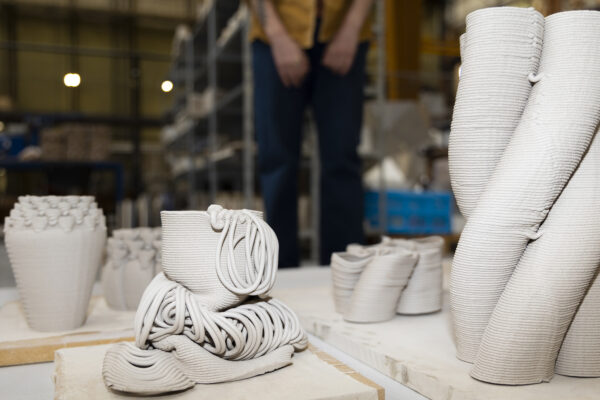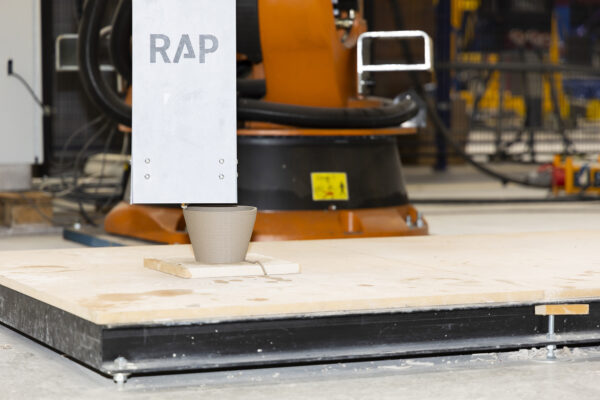

The architectural bookshelf by Miles Le Gras and Lucas ter Hall (Studio RAP)
The wharf of the former Rotterdamsche Droogdok Maatschappij is the location of Studio RAP – known for their innovative 3D-printed ceramic façades. For Building Talent, the architects worked with multidisciplinary designer Miles Le Gras on a special project. After countless experiments with twisted vases, ingenious fruit bowls, unusual stools, and cracked and collapsed designs, Miles mastered the capabilities of RAP’s special clay printer in the robot workshop. It resulted in architectural modular bookshelves that are lying here to dry before being fired and glazed.
Initially, architect Lucas ter Hall, together with Wessel van Beerendonk, the founder of Studio RAP, wanted to investigate how a contemporary 3D-printed ceramic façade could look if you harnessed the creativity of a talented young designer like Miles Le Gras. But very soon, Miles and Lucas agreed that modifying the application would produce a more exciting result. ‘Instead of doing what we already specialize in, which is printing façade panels and tiles for architectural projects using a technique we have developed ourselves, working with someone outside our own discipline opens up new possibilities and potentially unexpected, exciting solutions,’ Lucas suspected. The collaboration is therefore an excellent opportunity to develop an interior product that contains the DNA of both of them, they believe.
And so, many experiments and failures later, Miles came up with a design that brought the two worlds together: an architectural bookshelf with an unusual and detailed organic pattern. ‘This particular print robot is not only faster than other 3D printers, but it can also print a variety of heights within a single layer. This justifies the design, otherwise I might just as well have used an ordinary 3D printer,’ explains Miles.
Working with someone outside our own discipline opens up new possibilities and potentially unexpected, exciting solutions – Lucas ter Hall



Lucas calls this way of working instructive. ‘Miles inspires me to experiment more in our own work,’ he says. In turn, Miles calls this project a once-in-a-lifetime opportunity to work at RAP with their state-of-the-art technology; he was given complete freedom to experiment with clay and the robotic arm. ‘For my graduation project Vestige, I investigated the ceramic slip-casting method. By working on a different scale and with a different technique now, I am getting to know this unpredictable material better and better. It broadens my knowledge of ceramics.’
The knowledge of techniques he has gained also offers new perspectives that can take his design practice further in the future. For example, over the past few months Miles has been exploring the possibilities and limits of the materiality and texture of clay and playing with hollow forms and reliefs. He has sketched designs, converted them into 3D models and experimented with printing the different shapes using parametric software.
Lucas, who specializes in parametric design and robotic production, helped him with this, because, according to him, a designer could never learn this from scratch in such a short time. ‘It took us three to five years to master working with the right clay compositions and thicknesses,’ he says, ‘but it only took a day to teach Miles what he needed to know.’ Afterwards, Miles went to work himself: ‘That was the best way for me to learn how to use the robotic arm and how the clay reacts to the technique. And if I get stuck, I come up with a solution myself.’



Miles and Lucas share the same passion: they are interested in how things are made, in techniques and processes, although these are different for the two of them. Miles has always been fascinated by materials and products that have a certain material intelligence. He is familiar with digital tools and 3D modelling, but uses them only as a basic toolkit to develop his own process. At Studio RAP, the digital and robotic aspect is central to achieving an industrialized and affordable product. It led to an interesting discussion between the architect and the designer about designing based on algorithms. What does it do to the unique hand of the maker, does that remain visible? ‘I approach algorithms as tools. That isn’t a less creative way of designing. It is both industrial and artisanal; our signature is always in it,’ says Lucas.



I design mainly interior products because I am attracted to the directness and materiality that an object can offer – Miles Le Gras
During the project, Miles made a shift from a more traditional and analogue working method to digital. ‘I made the best use of the robot and used the technology to design products with a new aesthetic that would be difficult to produce in any other way,’ explains Miles, who graduated from the Design Academy Eindhoven in 2020. Before that, he studied Industrial Design in Paris. Now he mostly lives and works in Paris again and travels to Rotterdam every fortnight to work on this project.
‘I design mainly interior products because I am attracted to the directness and materiality that an object can offer, but there is always a clear link to architecture in my designs. The complexity, scale and function – the built environment that shapes our lives – activate my imagination and are a prominent source of inspiration in my work,’ he says.
And so now there is a ceramic bookshelf that looks a bit like an ingeniously designed bridge. With the modular bookends in three different sizes, you will soon be able to put together a unique architectural structure. Miles cannot wait for the fired and glazed shelves to actually hang on the wall. And then just one question remains: how are they going to market the product?
Text: Viveka van Vliet





